CQUniversity ACCT20075 Report: Auditing and Ethical Practices of IAG
VerifiedAdded on 2023/06/07
|13
|2651
|447
Report
AI Summary
This report analyzes the auditing and ethical practices of Insurance Australia Group (IAG) for the year 2017. It begins by applying auditing procedures to assess the fairness of IAG's financial statements, including an evaluation of planning materiality. The report then examines the relevance of materiality in auditing and computes the planning materiality for IAG. It includes analytical procedures, calculating and analyzing significant financial ratios to identify potential risks. Section 3 analyzes the company's cash flow statement, discussing significant items. The report also analyzes IAG's audit report, highlighting key considerations by the auditor. The report concludes with an overview of the financial statements, the going concern principle, and the audit report.
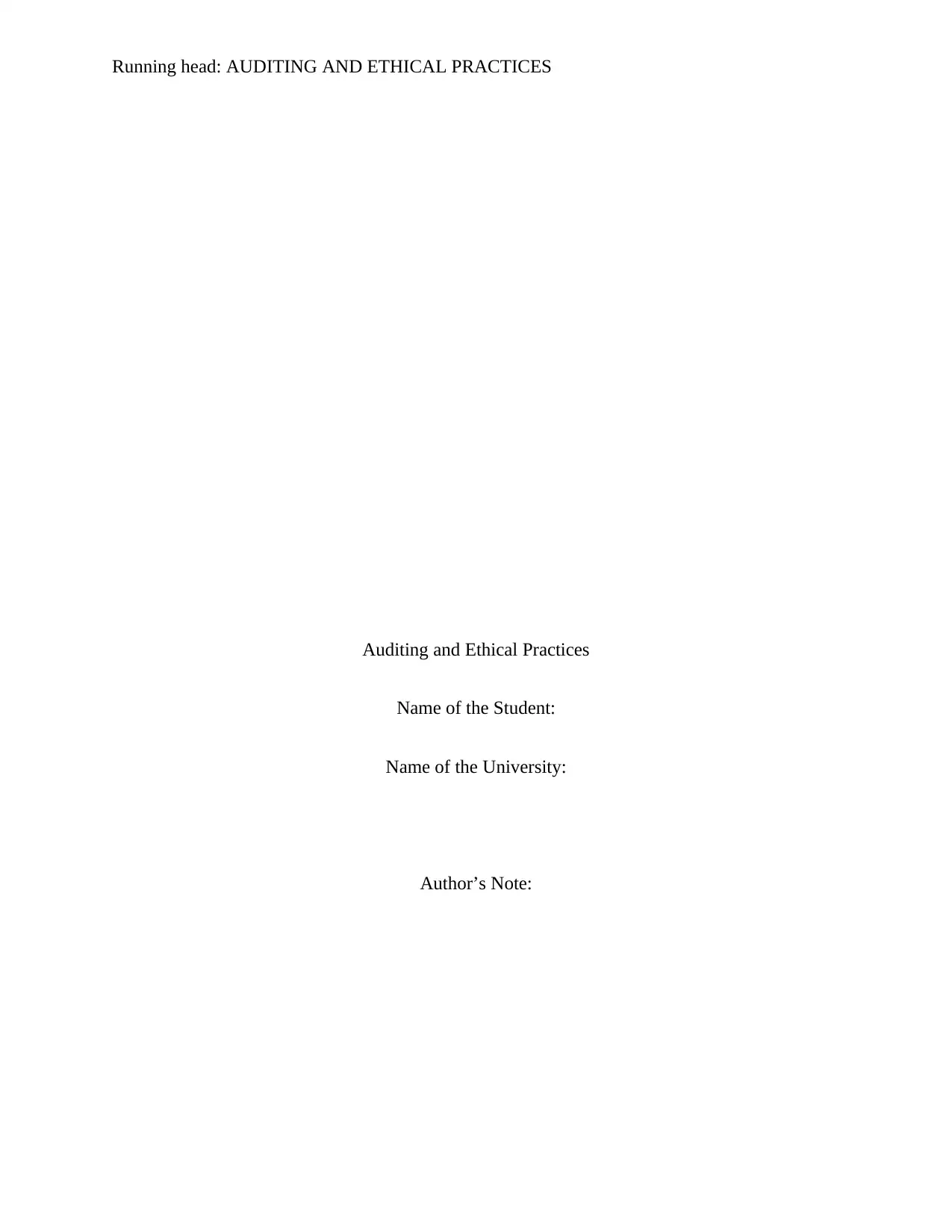
Running head: AUDITING AND ETHICAL PRACTICES
Auditing and Ethical Practices
Name of the Student:
Name of the University:
Author’s Note:
Auditing and Ethical Practices
Name of the Student:
Name of the University:
Author’s Note:
Paraphrase This Document
Need a fresh take? Get an instant paraphrase of this document with our AI Paraphraser
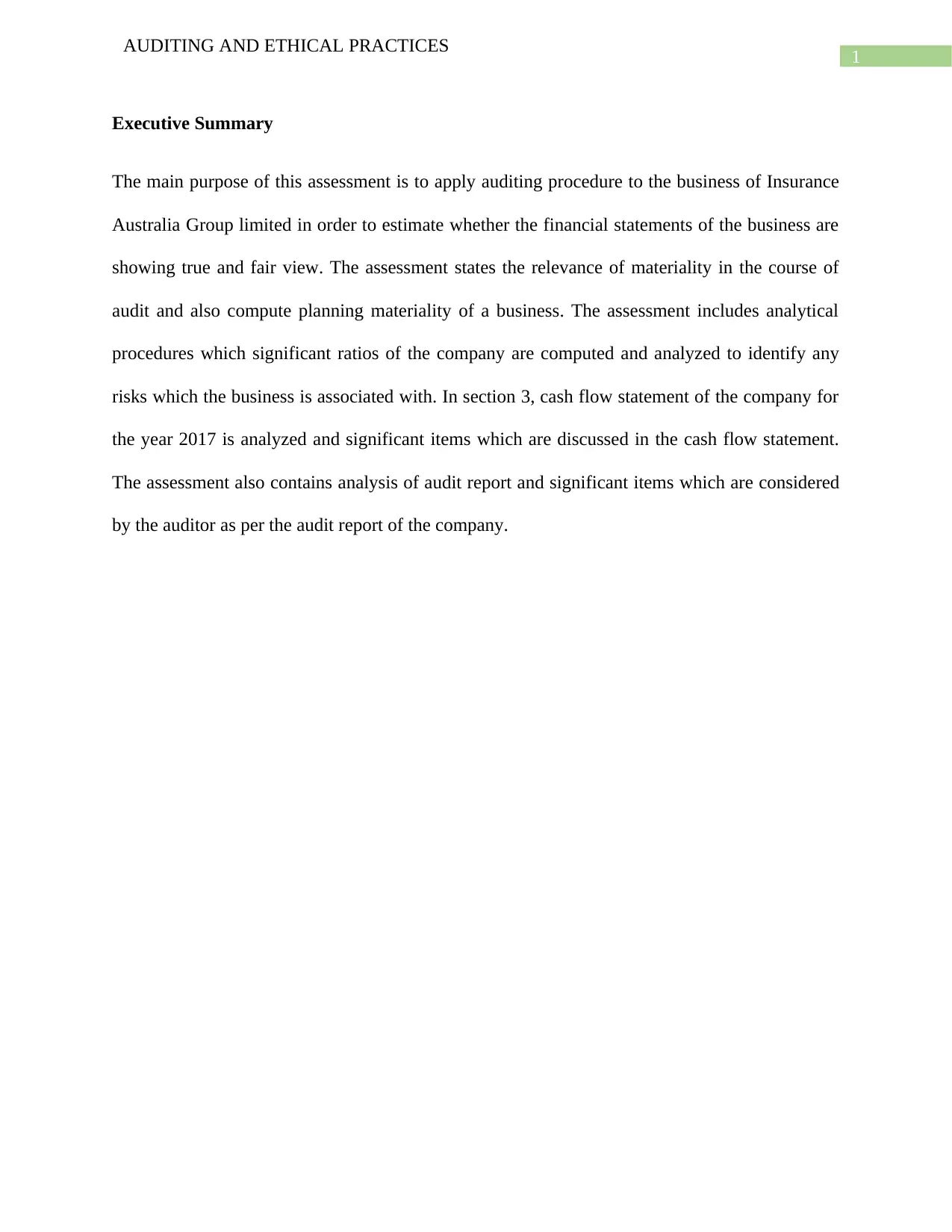
1
AUDITING AND ETHICAL PRACTICES
Executive Summary
The main purpose of this assessment is to apply auditing procedure to the business of Insurance
Australia Group limited in order to estimate whether the financial statements of the business are
showing true and fair view. The assessment states the relevance of materiality in the course of
audit and also compute planning materiality of a business. The assessment includes analytical
procedures which significant ratios of the company are computed and analyzed to identify any
risks which the business is associated with. In section 3, cash flow statement of the company for
the year 2017 is analyzed and significant items which are discussed in the cash flow statement.
The assessment also contains analysis of audit report and significant items which are considered
by the auditor as per the audit report of the company.
AUDITING AND ETHICAL PRACTICES
Executive Summary
The main purpose of this assessment is to apply auditing procedure to the business of Insurance
Australia Group limited in order to estimate whether the financial statements of the business are
showing true and fair view. The assessment states the relevance of materiality in the course of
audit and also compute planning materiality of a business. The assessment includes analytical
procedures which significant ratios of the company are computed and analyzed to identify any
risks which the business is associated with. In section 3, cash flow statement of the company for
the year 2017 is analyzed and significant items which are discussed in the cash flow statement.
The assessment also contains analysis of audit report and significant items which are considered
by the auditor as per the audit report of the company.
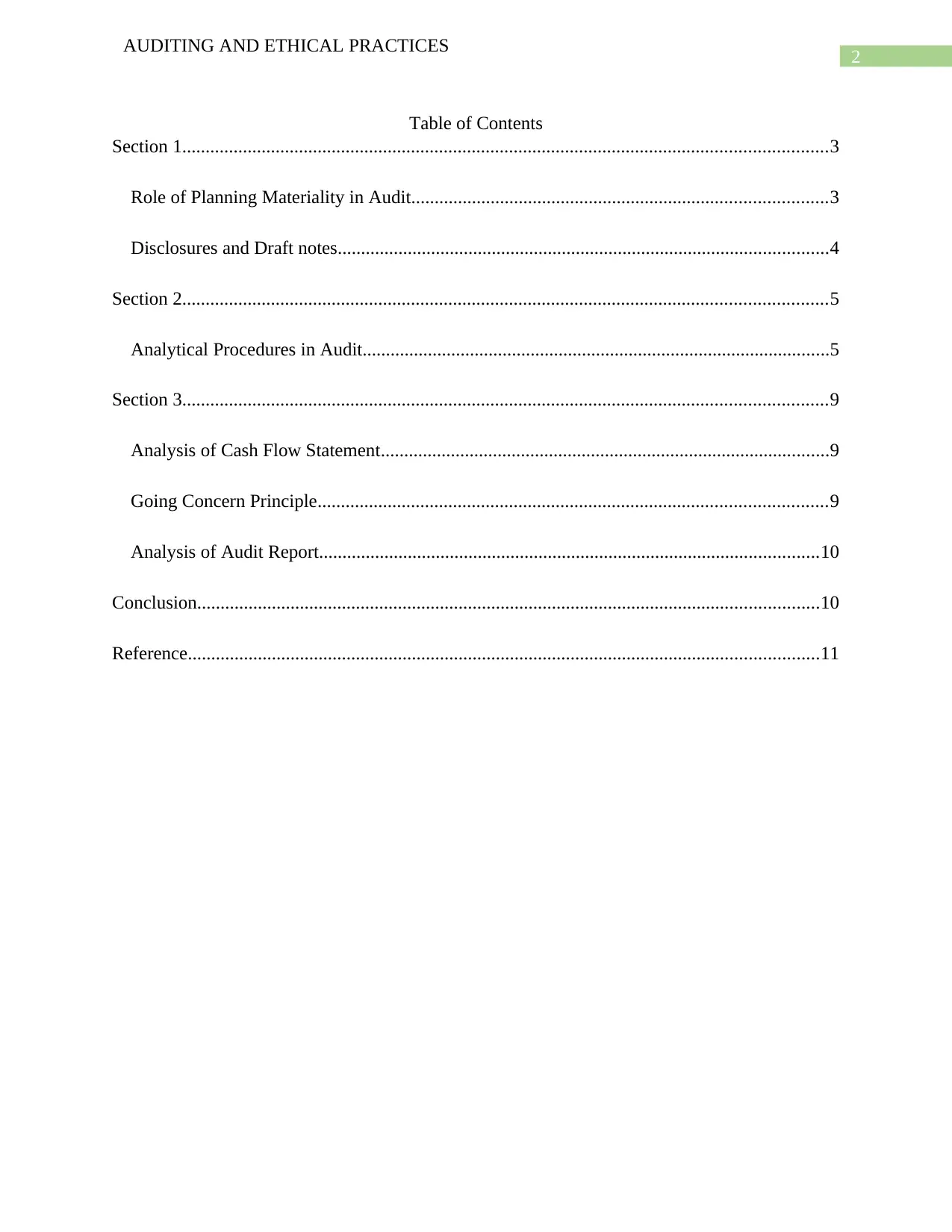
2
AUDITING AND ETHICAL PRACTICES
Table of Contents
Section 1..........................................................................................................................................3
Role of Planning Materiality in Audit.........................................................................................3
Disclosures and Draft notes.........................................................................................................4
Section 2..........................................................................................................................................5
Analytical Procedures in Audit....................................................................................................5
Section 3..........................................................................................................................................9
Analysis of Cash Flow Statement................................................................................................9
Going Concern Principle.............................................................................................................9
Analysis of Audit Report...........................................................................................................10
Conclusion.....................................................................................................................................10
Reference.......................................................................................................................................11
AUDITING AND ETHICAL PRACTICES
Table of Contents
Section 1..........................................................................................................................................3
Role of Planning Materiality in Audit.........................................................................................3
Disclosures and Draft notes.........................................................................................................4
Section 2..........................................................................................................................................5
Analytical Procedures in Audit....................................................................................................5
Section 3..........................................................................................................................................9
Analysis of Cash Flow Statement................................................................................................9
Going Concern Principle.............................................................................................................9
Analysis of Audit Report...........................................................................................................10
Conclusion.....................................................................................................................................10
Reference.......................................................................................................................................11
⊘ This is a preview!⊘
Do you want full access?
Subscribe today to unlock all pages.

Trusted by 1+ million students worldwide
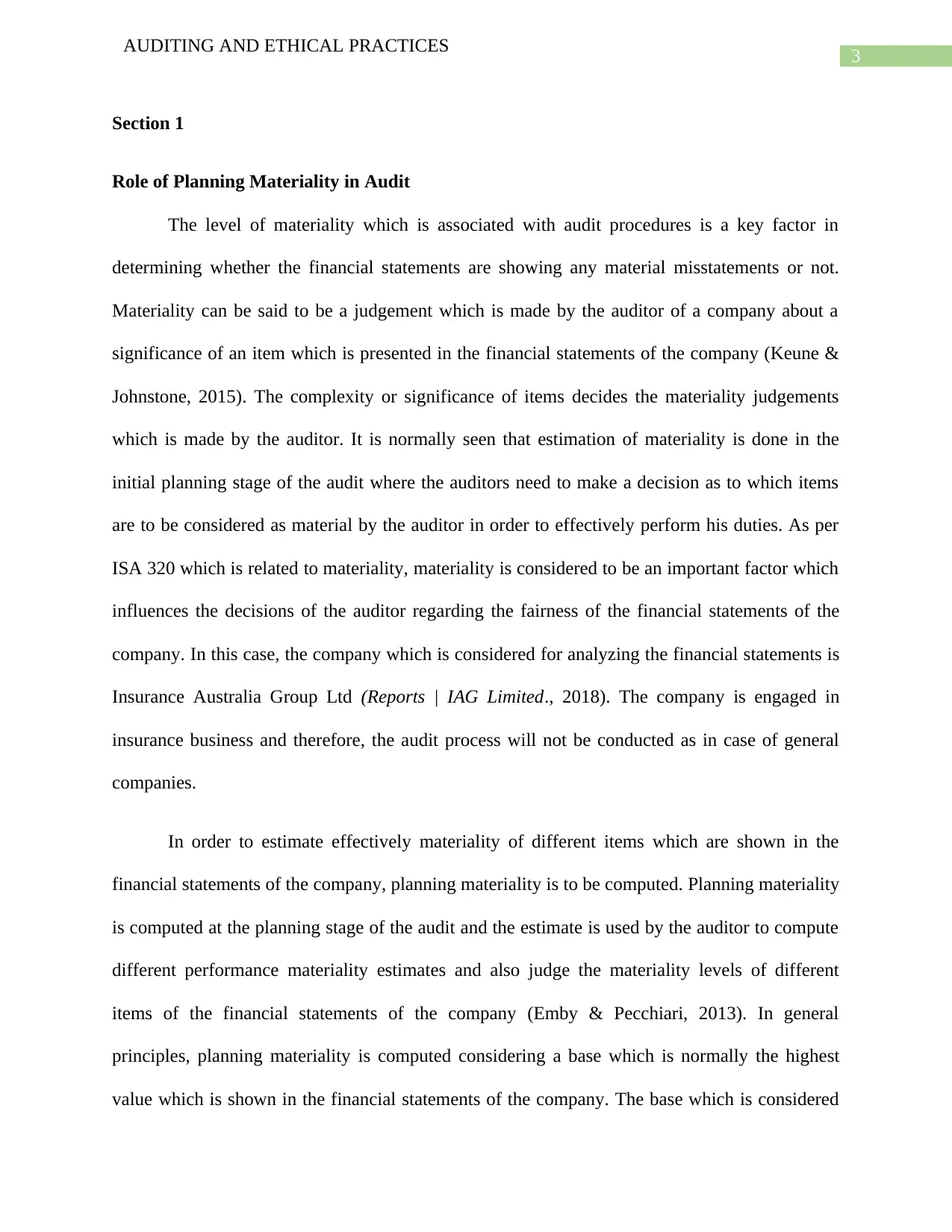
3
AUDITING AND ETHICAL PRACTICES
Section 1
Role of Planning Materiality in Audit
The level of materiality which is associated with audit procedures is a key factor in
determining whether the financial statements are showing any material misstatements or not.
Materiality can be said to be a judgement which is made by the auditor of a company about a
significance of an item which is presented in the financial statements of the company (Keune &
Johnstone, 2015). The complexity or significance of items decides the materiality judgements
which is made by the auditor. It is normally seen that estimation of materiality is done in the
initial planning stage of the audit where the auditors need to make a decision as to which items
are to be considered as material by the auditor in order to effectively perform his duties. As per
ISA 320 which is related to materiality, materiality is considered to be an important factor which
influences the decisions of the auditor regarding the fairness of the financial statements of the
company. In this case, the company which is considered for analyzing the financial statements is
Insurance Australia Group Ltd (Reports | IAG Limited., 2018). The company is engaged in
insurance business and therefore, the audit process will not be conducted as in case of general
companies.
In order to estimate effectively materiality of different items which are shown in the
financial statements of the company, planning materiality is to be computed. Planning materiality
is computed at the planning stage of the audit and the estimate is used by the auditor to compute
different performance materiality estimates and also judge the materiality levels of different
items of the financial statements of the company (Emby & Pecchiari, 2013). In general
principles, planning materiality is computed considering a base which is normally the highest
value which is shown in the financial statements of the company. The base which is considered
AUDITING AND ETHICAL PRACTICES
Section 1
Role of Planning Materiality in Audit
The level of materiality which is associated with audit procedures is a key factor in
determining whether the financial statements are showing any material misstatements or not.
Materiality can be said to be a judgement which is made by the auditor of a company about a
significance of an item which is presented in the financial statements of the company (Keune &
Johnstone, 2015). The complexity or significance of items decides the materiality judgements
which is made by the auditor. It is normally seen that estimation of materiality is done in the
initial planning stage of the audit where the auditors need to make a decision as to which items
are to be considered as material by the auditor in order to effectively perform his duties. As per
ISA 320 which is related to materiality, materiality is considered to be an important factor which
influences the decisions of the auditor regarding the fairness of the financial statements of the
company. In this case, the company which is considered for analyzing the financial statements is
Insurance Australia Group Ltd (Reports | IAG Limited., 2018). The company is engaged in
insurance business and therefore, the audit process will not be conducted as in case of general
companies.
In order to estimate effectively materiality of different items which are shown in the
financial statements of the company, planning materiality is to be computed. Planning materiality
is computed at the planning stage of the audit and the estimate is used by the auditor to compute
different performance materiality estimates and also judge the materiality levels of different
items of the financial statements of the company (Emby & Pecchiari, 2013). In general
principles, planning materiality is computed considering a base which is normally the highest
value which is shown in the financial statements of the company. The base which is considered
Paraphrase This Document
Need a fresh take? Get an instant paraphrase of this document with our AI Paraphraser
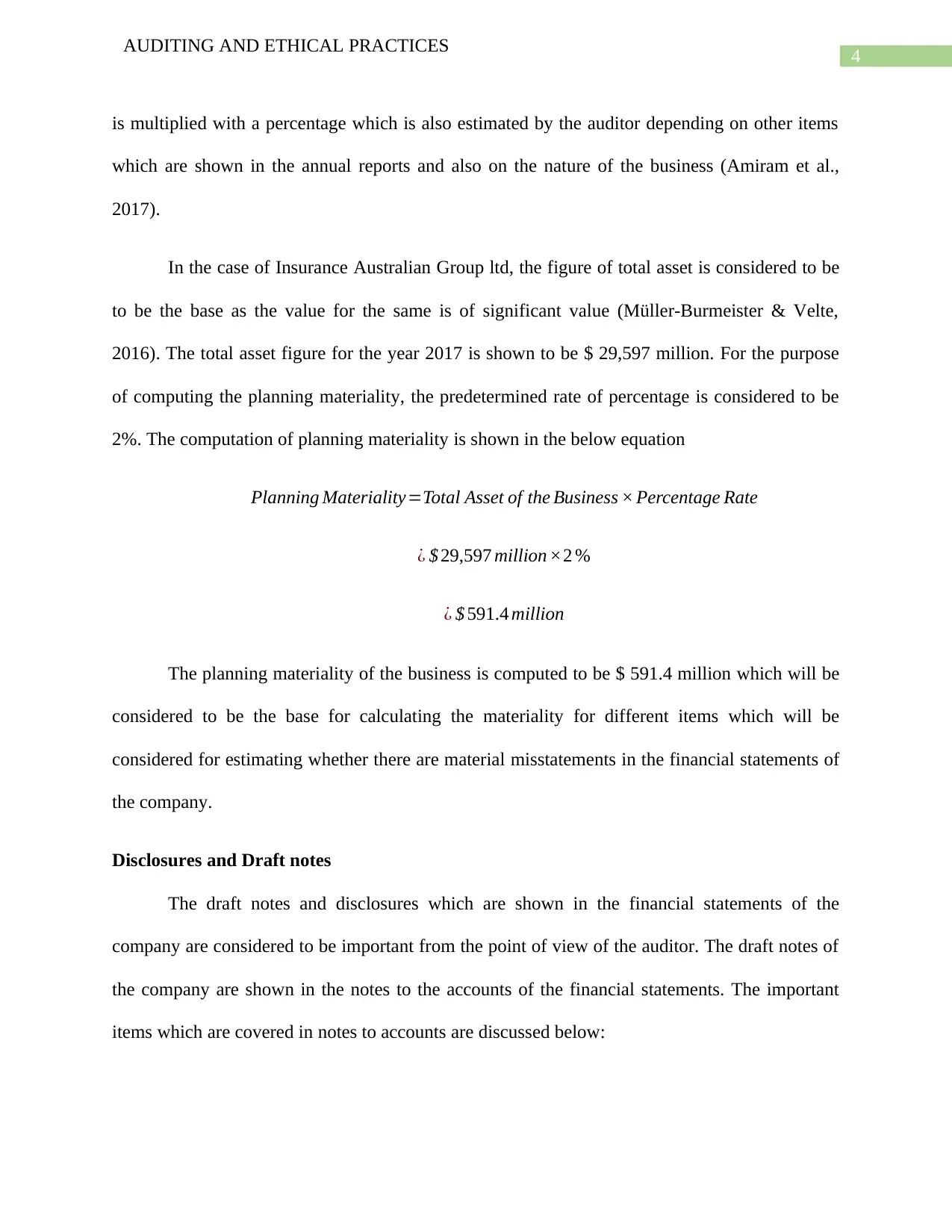
4
AUDITING AND ETHICAL PRACTICES
is multiplied with a percentage which is also estimated by the auditor depending on other items
which are shown in the annual reports and also on the nature of the business (Amiram et al.,
2017).
In the case of Insurance Australian Group ltd, the figure of total asset is considered to be
to be the base as the value for the same is of significant value (Müller-Burmeister & Velte,
2016). The total asset figure for the year 2017 is shown to be $ 29,597 million. For the purpose
of computing the planning materiality, the predetermined rate of percentage is considered to be
2%. The computation of planning materiality is shown in the below equation
Planning Materiality=Total Asset of the Business × Percentage Rate
¿ $ 29,597 million ×2 %
¿ $ 591.4 million
The planning materiality of the business is computed to be $ 591.4 million which will be
considered to be the base for calculating the materiality for different items which will be
considered for estimating whether there are material misstatements in the financial statements of
the company.
Disclosures and Draft notes
The draft notes and disclosures which are shown in the financial statements of the
company are considered to be important from the point of view of the auditor. The draft notes of
the company are shown in the notes to the accounts of the financial statements. The important
items which are covered in notes to accounts are discussed below:
AUDITING AND ETHICAL PRACTICES
is multiplied with a percentage which is also estimated by the auditor depending on other items
which are shown in the annual reports and also on the nature of the business (Amiram et al.,
2017).
In the case of Insurance Australian Group ltd, the figure of total asset is considered to be
to be the base as the value for the same is of significant value (Müller-Burmeister & Velte,
2016). The total asset figure for the year 2017 is shown to be $ 29,597 million. For the purpose
of computing the planning materiality, the predetermined rate of percentage is considered to be
2%. The computation of planning materiality is shown in the below equation
Planning Materiality=Total Asset of the Business × Percentage Rate
¿ $ 29,597 million ×2 %
¿ $ 591.4 million
The planning materiality of the business is computed to be $ 591.4 million which will be
considered to be the base for calculating the materiality for different items which will be
considered for estimating whether there are material misstatements in the financial statements of
the company.
Disclosures and Draft notes
The draft notes and disclosures which are shown in the financial statements of the
company are considered to be important from the point of view of the auditor. The draft notes of
the company are shown in the notes to the accounts of the financial statements. The important
items which are covered in notes to accounts are discussed below:
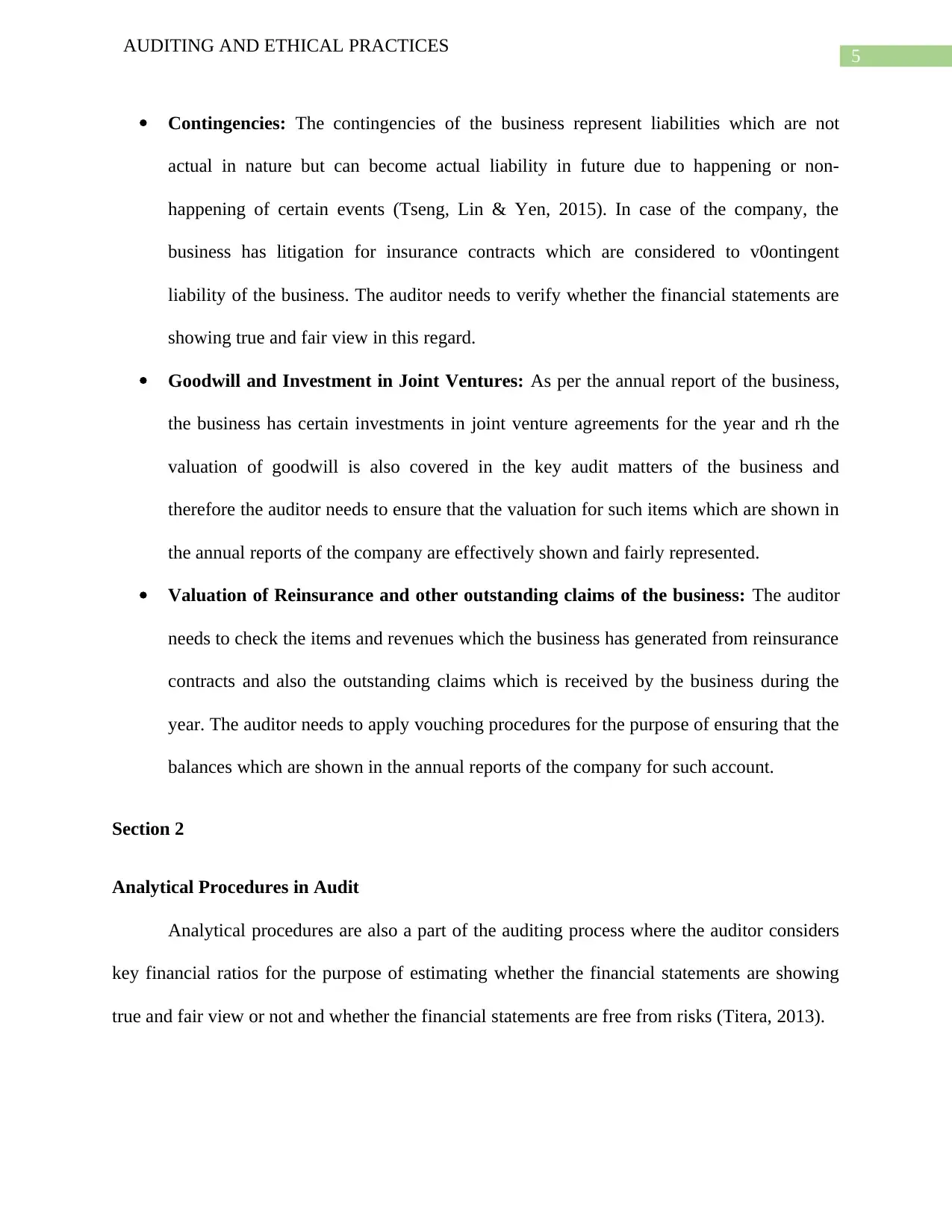
5
AUDITING AND ETHICAL PRACTICES
Contingencies: The contingencies of the business represent liabilities which are not
actual in nature but can become actual liability in future due to happening or non-
happening of certain events (Tseng, Lin & Yen, 2015). In case of the company, the
business has litigation for insurance contracts which are considered to v0ontingent
liability of the business. The auditor needs to verify whether the financial statements are
showing true and fair view in this regard.
Goodwill and Investment in Joint Ventures: As per the annual report of the business,
the business has certain investments in joint venture agreements for the year and rh the
valuation of goodwill is also covered in the key audit matters of the business and
therefore the auditor needs to ensure that the valuation for such items which are shown in
the annual reports of the company are effectively shown and fairly represented.
Valuation of Reinsurance and other outstanding claims of the business: The auditor
needs to check the items and revenues which the business has generated from reinsurance
contracts and also the outstanding claims which is received by the business during the
year. The auditor needs to apply vouching procedures for the purpose of ensuring that the
balances which are shown in the annual reports of the company for such account.
Section 2
Analytical Procedures in Audit
Analytical procedures are also a part of the auditing process where the auditor considers
key financial ratios for the purpose of estimating whether the financial statements are showing
true and fair view or not and whether the financial statements are free from risks (Titera, 2013).
AUDITING AND ETHICAL PRACTICES
Contingencies: The contingencies of the business represent liabilities which are not
actual in nature but can become actual liability in future due to happening or non-
happening of certain events (Tseng, Lin & Yen, 2015). In case of the company, the
business has litigation for insurance contracts which are considered to v0ontingent
liability of the business. The auditor needs to verify whether the financial statements are
showing true and fair view in this regard.
Goodwill and Investment in Joint Ventures: As per the annual report of the business,
the business has certain investments in joint venture agreements for the year and rh the
valuation of goodwill is also covered in the key audit matters of the business and
therefore the auditor needs to ensure that the valuation for such items which are shown in
the annual reports of the company are effectively shown and fairly represented.
Valuation of Reinsurance and other outstanding claims of the business: The auditor
needs to check the items and revenues which the business has generated from reinsurance
contracts and also the outstanding claims which is received by the business during the
year. The auditor needs to apply vouching procedures for the purpose of ensuring that the
balances which are shown in the annual reports of the company for such account.
Section 2
Analytical Procedures in Audit
Analytical procedures are also a part of the auditing process where the auditor considers
key financial ratios for the purpose of estimating whether the financial statements are showing
true and fair view or not and whether the financial statements are free from risks (Titera, 2013).
⊘ This is a preview!⊘
Do you want full access?
Subscribe today to unlock all pages.

Trusted by 1+ million students worldwide
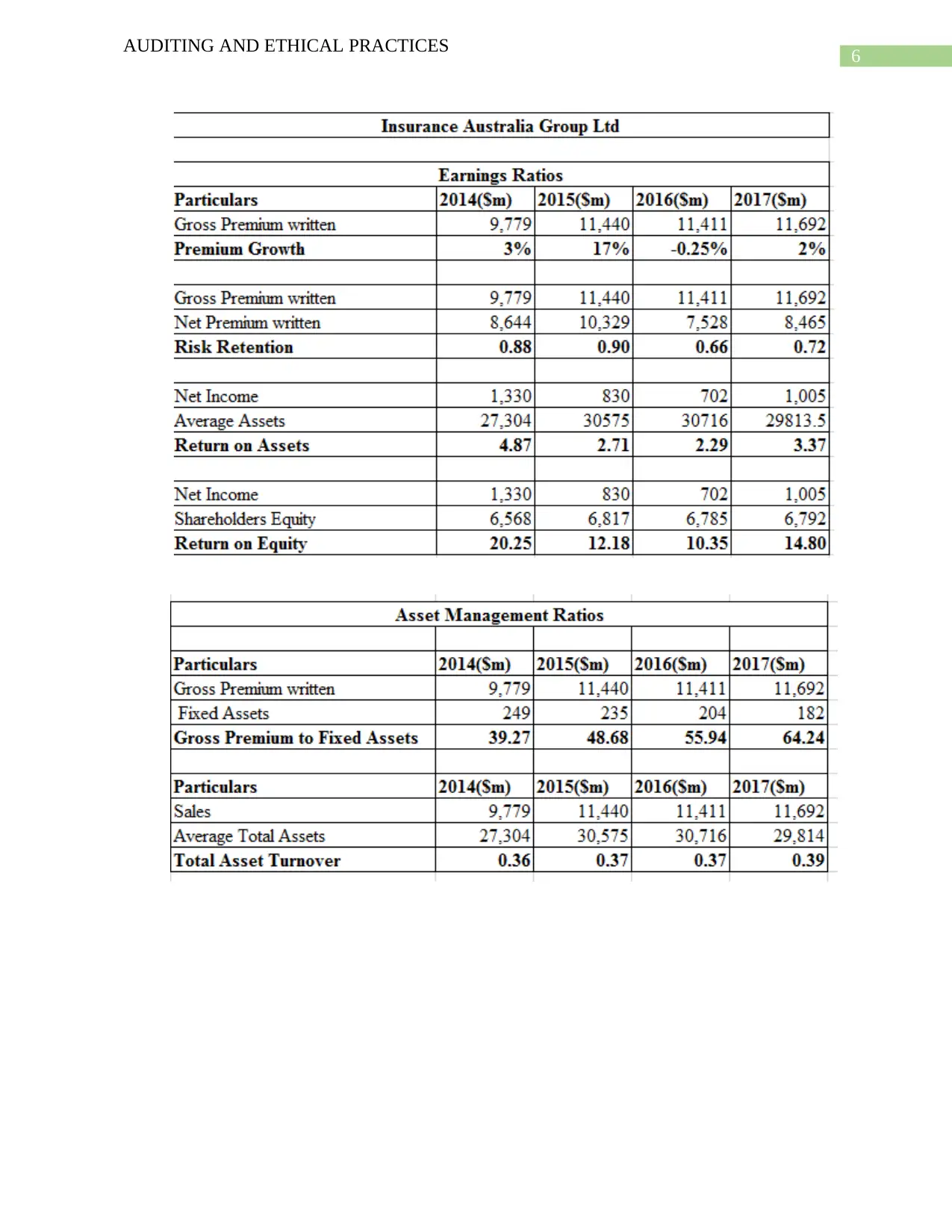
6
AUDITING AND ETHICAL PRACTICES
AUDITING AND ETHICAL PRACTICES
Paraphrase This Document
Need a fresh take? Get an instant paraphrase of this document with our AI Paraphraser
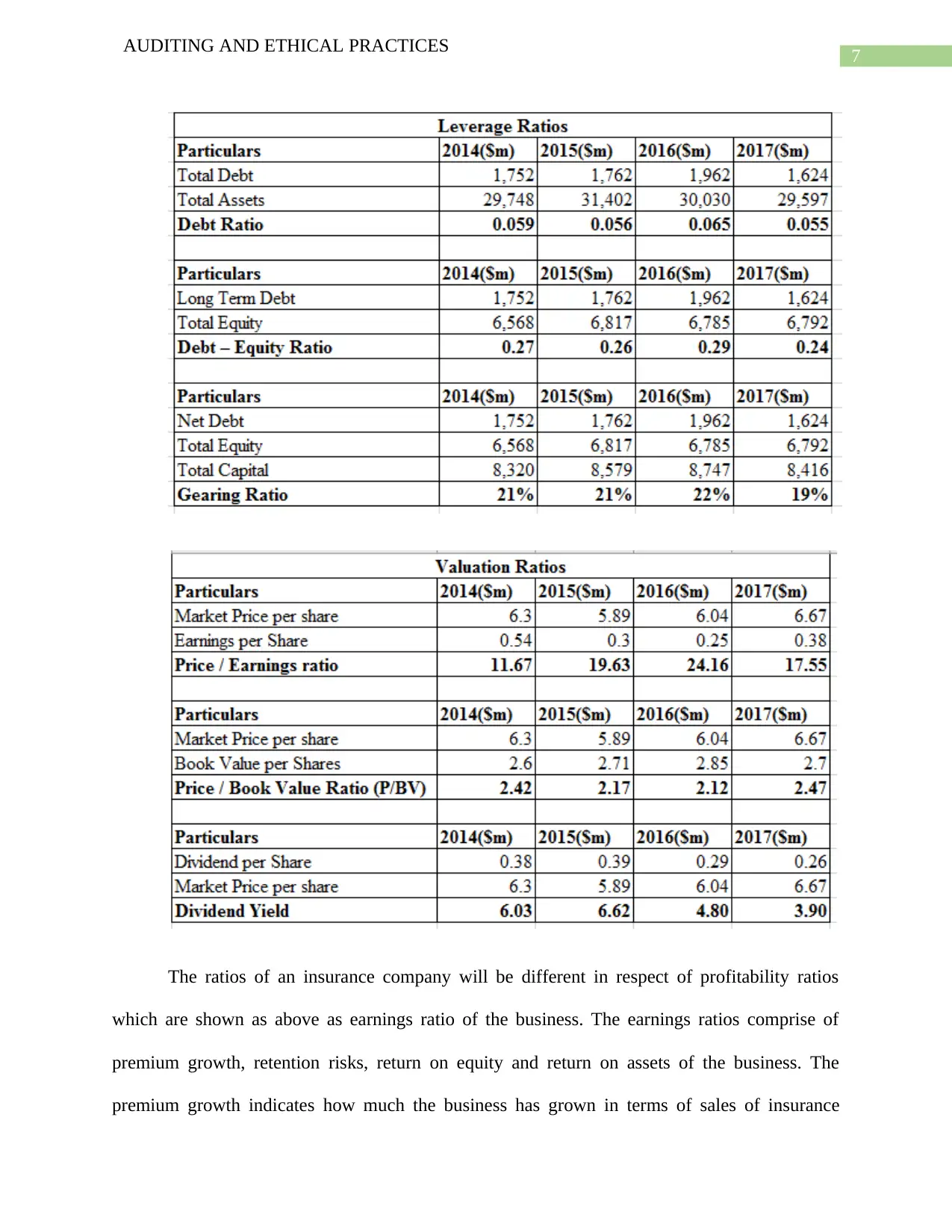
7
AUDITING AND ETHICAL PRACTICES
The ratios of an insurance company will be different in respect of profitability ratios
which are shown as above as earnings ratio of the business. The earnings ratios comprise of
premium growth, retention risks, return on equity and return on assets of the business. The
premium growth indicates how much the business has grown in terms of sales of insurance
AUDITING AND ETHICAL PRACTICES
The ratios of an insurance company will be different in respect of profitability ratios
which are shown as above as earnings ratio of the business. The earnings ratios comprise of
premium growth, retention risks, return on equity and return on assets of the business. The
premium growth indicates how much the business has grown in terms of sales of insurance
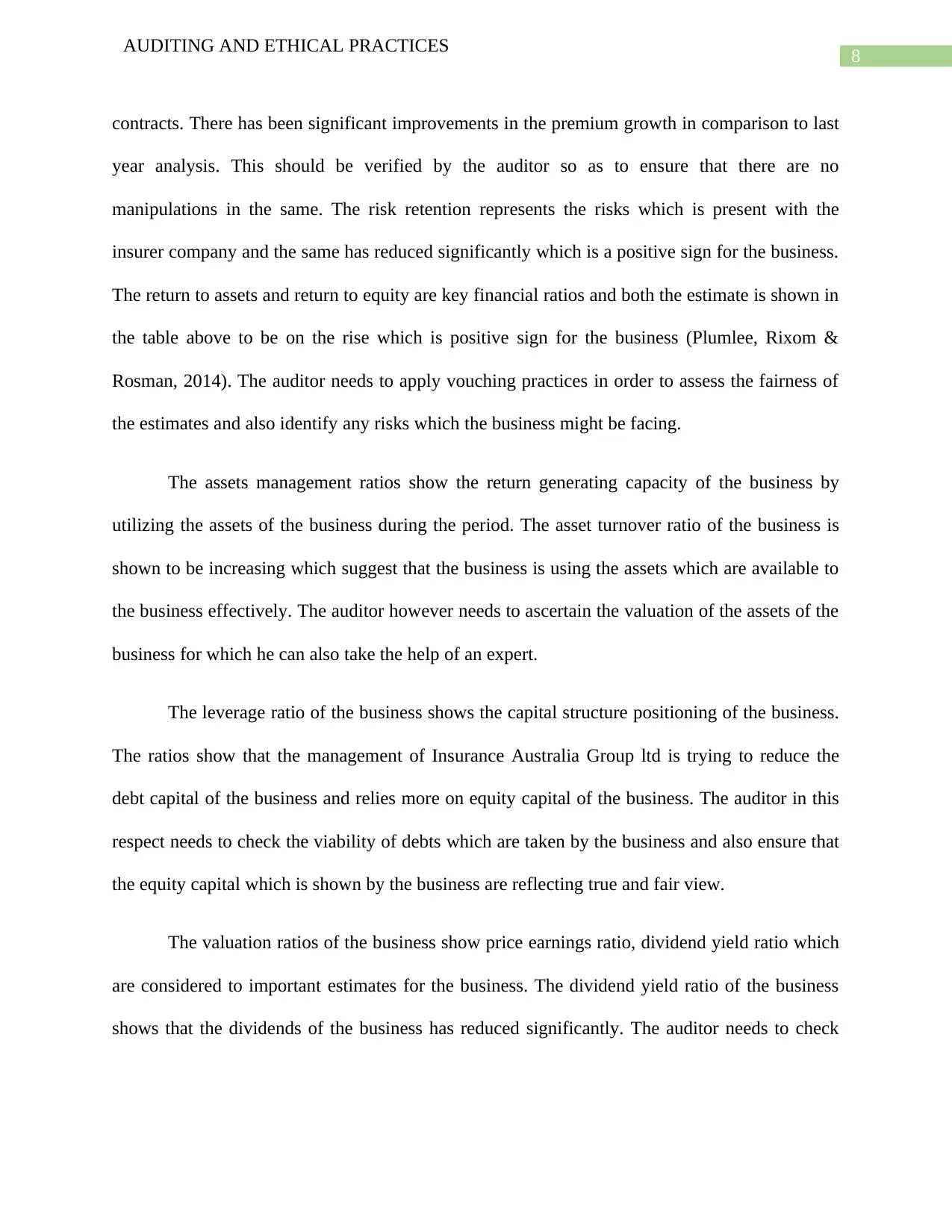
8
AUDITING AND ETHICAL PRACTICES
contracts. There has been significant improvements in the premium growth in comparison to last
year analysis. This should be verified by the auditor so as to ensure that there are no
manipulations in the same. The risk retention represents the risks which is present with the
insurer company and the same has reduced significantly which is a positive sign for the business.
The return to assets and return to equity are key financial ratios and both the estimate is shown in
the table above to be on the rise which is positive sign for the business (Plumlee, Rixom &
Rosman, 2014). The auditor needs to apply vouching practices in order to assess the fairness of
the estimates and also identify any risks which the business might be facing.
The assets management ratios show the return generating capacity of the business by
utilizing the assets of the business during the period. The asset turnover ratio of the business is
shown to be increasing which suggest that the business is using the assets which are available to
the business effectively. The auditor however needs to ascertain the valuation of the assets of the
business for which he can also take the help of an expert.
The leverage ratio of the business shows the capital structure positioning of the business.
The ratios show that the management of Insurance Australia Group ltd is trying to reduce the
debt capital of the business and relies more on equity capital of the business. The auditor in this
respect needs to check the viability of debts which are taken by the business and also ensure that
the equity capital which is shown by the business are reflecting true and fair view.
The valuation ratios of the business show price earnings ratio, dividend yield ratio which
are considered to important estimates for the business. The dividend yield ratio of the business
shows that the dividends of the business has reduced significantly. The auditor needs to check
AUDITING AND ETHICAL PRACTICES
contracts. There has been significant improvements in the premium growth in comparison to last
year analysis. This should be verified by the auditor so as to ensure that there are no
manipulations in the same. The risk retention represents the risks which is present with the
insurer company and the same has reduced significantly which is a positive sign for the business.
The return to assets and return to equity are key financial ratios and both the estimate is shown in
the table above to be on the rise which is positive sign for the business (Plumlee, Rixom &
Rosman, 2014). The auditor needs to apply vouching practices in order to assess the fairness of
the estimates and also identify any risks which the business might be facing.
The assets management ratios show the return generating capacity of the business by
utilizing the assets of the business during the period. The asset turnover ratio of the business is
shown to be increasing which suggest that the business is using the assets which are available to
the business effectively. The auditor however needs to ascertain the valuation of the assets of the
business for which he can also take the help of an expert.
The leverage ratio of the business shows the capital structure positioning of the business.
The ratios show that the management of Insurance Australia Group ltd is trying to reduce the
debt capital of the business and relies more on equity capital of the business. The auditor in this
respect needs to check the viability of debts which are taken by the business and also ensure that
the equity capital which is shown by the business are reflecting true and fair view.
The valuation ratios of the business show price earnings ratio, dividend yield ratio which
are considered to important estimates for the business. The dividend yield ratio of the business
shows that the dividends of the business has reduced significantly. The auditor needs to check
⊘ This is a preview!⊘
Do you want full access?
Subscribe today to unlock all pages.

Trusted by 1+ million students worldwide
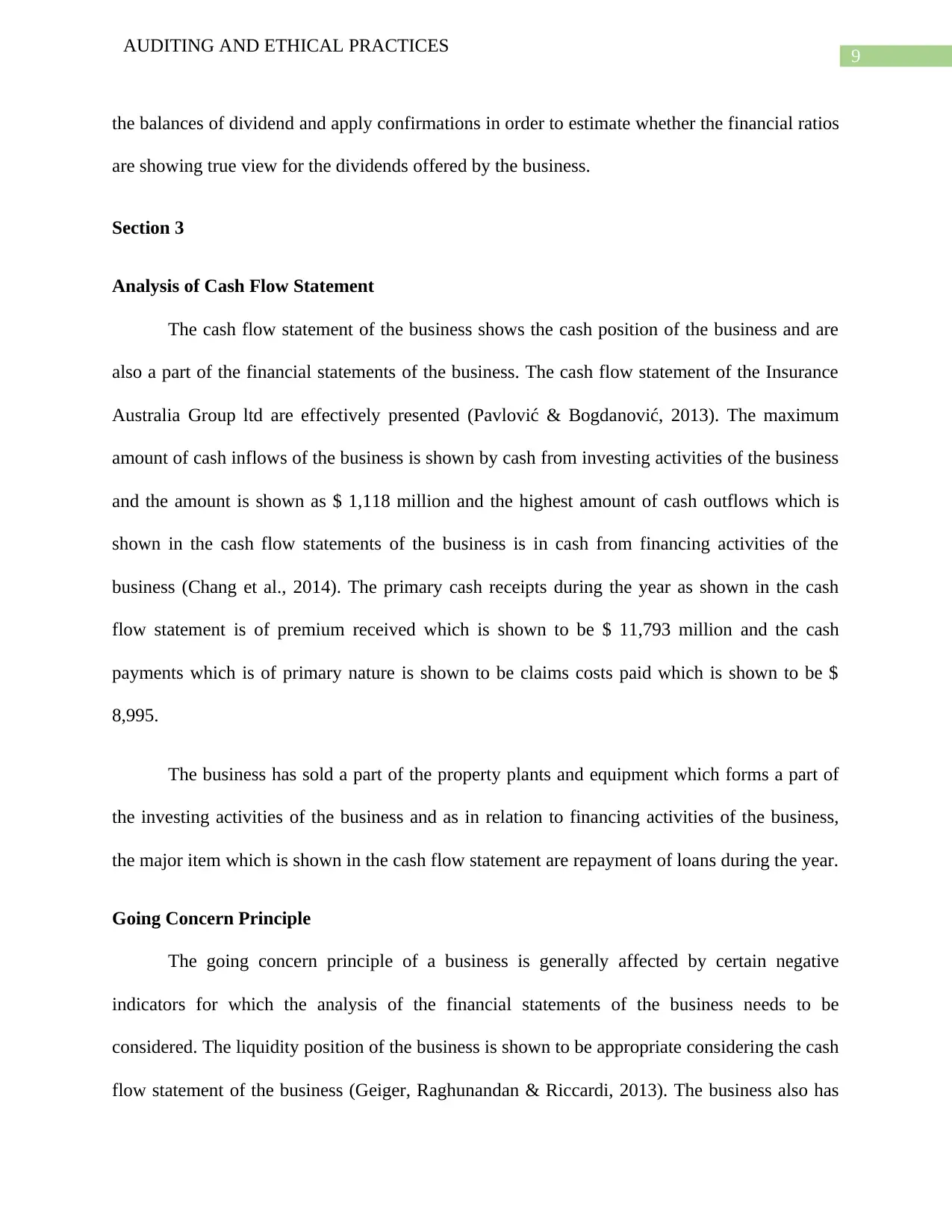
9
AUDITING AND ETHICAL PRACTICES
the balances of dividend and apply confirmations in order to estimate whether the financial ratios
are showing true view for the dividends offered by the business.
Section 3
Analysis of Cash Flow Statement
The cash flow statement of the business shows the cash position of the business and are
also a part of the financial statements of the business. The cash flow statement of the Insurance
Australia Group ltd are effectively presented (Pavlović & Bogdanović, 2013). The maximum
amount of cash inflows of the business is shown by cash from investing activities of the business
and the amount is shown as $ 1,118 million and the highest amount of cash outflows which is
shown in the cash flow statements of the business is in cash from financing activities of the
business (Chang et al., 2014). The primary cash receipts during the year as shown in the cash
flow statement is of premium received which is shown to be $ 11,793 million and the cash
payments which is of primary nature is shown to be claims costs paid which is shown to be $
8,995.
The business has sold a part of the property plants and equipment which forms a part of
the investing activities of the business and as in relation to financing activities of the business,
the major item which is shown in the cash flow statement are repayment of loans during the year.
Going Concern Principle
The going concern principle of a business is generally affected by certain negative
indicators for which the analysis of the financial statements of the business needs to be
considered. The liquidity position of the business is shown to be appropriate considering the cash
flow statement of the business (Geiger, Raghunandan & Riccardi, 2013). The business also has
AUDITING AND ETHICAL PRACTICES
the balances of dividend and apply confirmations in order to estimate whether the financial ratios
are showing true view for the dividends offered by the business.
Section 3
Analysis of Cash Flow Statement
The cash flow statement of the business shows the cash position of the business and are
also a part of the financial statements of the business. The cash flow statement of the Insurance
Australia Group ltd are effectively presented (Pavlović & Bogdanović, 2013). The maximum
amount of cash inflows of the business is shown by cash from investing activities of the business
and the amount is shown as $ 1,118 million and the highest amount of cash outflows which is
shown in the cash flow statements of the business is in cash from financing activities of the
business (Chang et al., 2014). The primary cash receipts during the year as shown in the cash
flow statement is of premium received which is shown to be $ 11,793 million and the cash
payments which is of primary nature is shown to be claims costs paid which is shown to be $
8,995.
The business has sold a part of the property plants and equipment which forms a part of
the investing activities of the business and as in relation to financing activities of the business,
the major item which is shown in the cash flow statement are repayment of loans during the year.
Going Concern Principle
The going concern principle of a business is generally affected by certain negative
indicators for which the analysis of the financial statements of the business needs to be
considered. The liquidity position of the business is shown to be appropriate considering the cash
flow statement of the business (Geiger, Raghunandan & Riccardi, 2013). The business also has
Paraphrase This Document
Need a fresh take? Get an instant paraphrase of this document with our AI Paraphraser
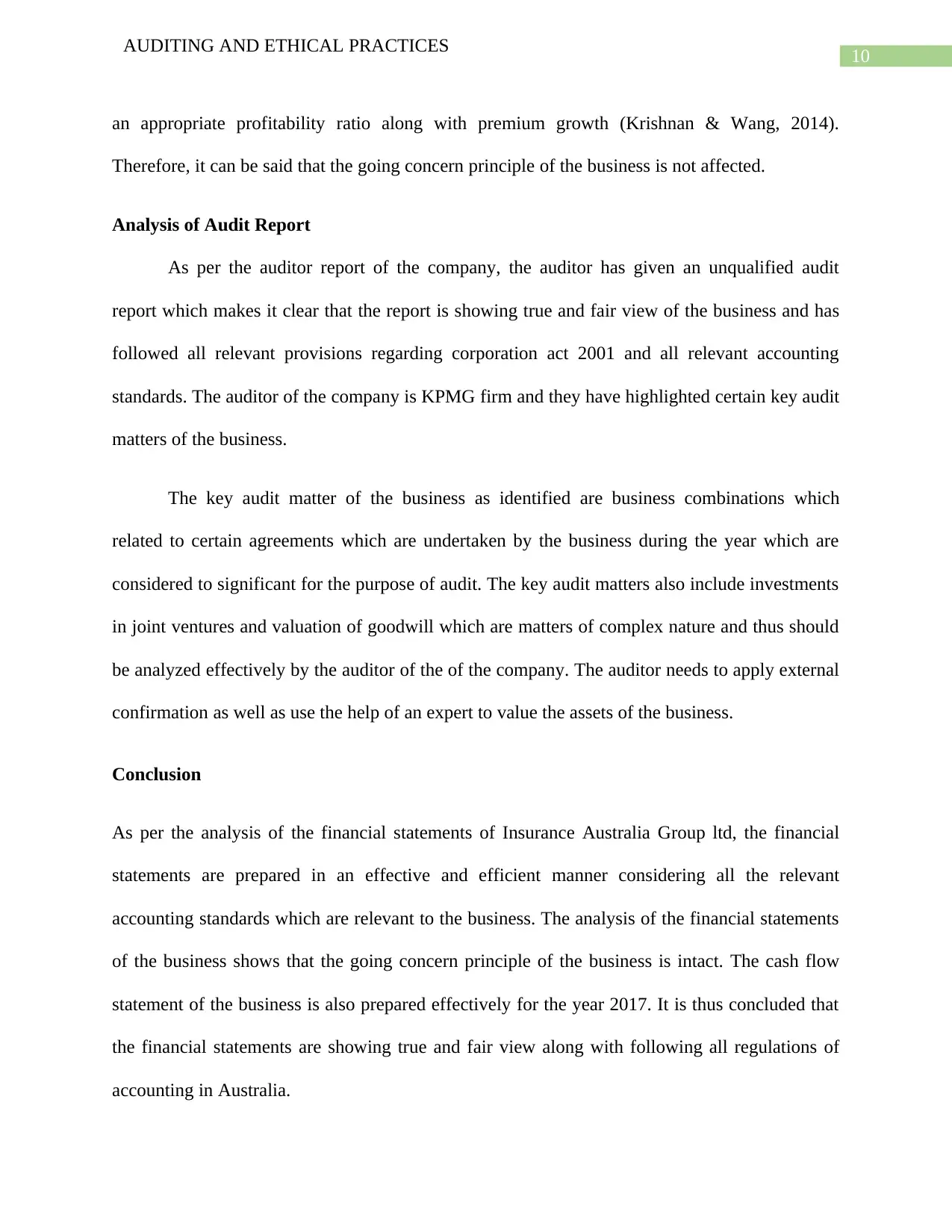
10
AUDITING AND ETHICAL PRACTICES
an appropriate profitability ratio along with premium growth (Krishnan & Wang, 2014).
Therefore, it can be said that the going concern principle of the business is not affected.
Analysis of Audit Report
As per the auditor report of the company, the auditor has given an unqualified audit
report which makes it clear that the report is showing true and fair view of the business and has
followed all relevant provisions regarding corporation act 2001 and all relevant accounting
standards. The auditor of the company is KPMG firm and they have highlighted certain key audit
matters of the business.
The key audit matter of the business as identified are business combinations which
related to certain agreements which are undertaken by the business during the year which are
considered to significant for the purpose of audit. The key audit matters also include investments
in joint ventures and valuation of goodwill which are matters of complex nature and thus should
be analyzed effectively by the auditor of the of the company. The auditor needs to apply external
confirmation as well as use the help of an expert to value the assets of the business.
Conclusion
As per the analysis of the financial statements of Insurance Australia Group ltd, the financial
statements are prepared in an effective and efficient manner considering all the relevant
accounting standards which are relevant to the business. The analysis of the financial statements
of the business shows that the going concern principle of the business is intact. The cash flow
statement of the business is also prepared effectively for the year 2017. It is thus concluded that
the financial statements are showing true and fair view along with following all regulations of
accounting in Australia.
AUDITING AND ETHICAL PRACTICES
an appropriate profitability ratio along with premium growth (Krishnan & Wang, 2014).
Therefore, it can be said that the going concern principle of the business is not affected.
Analysis of Audit Report
As per the auditor report of the company, the auditor has given an unqualified audit
report which makes it clear that the report is showing true and fair view of the business and has
followed all relevant provisions regarding corporation act 2001 and all relevant accounting
standards. The auditor of the company is KPMG firm and they have highlighted certain key audit
matters of the business.
The key audit matter of the business as identified are business combinations which
related to certain agreements which are undertaken by the business during the year which are
considered to significant for the purpose of audit. The key audit matters also include investments
in joint ventures and valuation of goodwill which are matters of complex nature and thus should
be analyzed effectively by the auditor of the of the company. The auditor needs to apply external
confirmation as well as use the help of an expert to value the assets of the business.
Conclusion
As per the analysis of the financial statements of Insurance Australia Group ltd, the financial
statements are prepared in an effective and efficient manner considering all the relevant
accounting standards which are relevant to the business. The analysis of the financial statements
of the business shows that the going concern principle of the business is intact. The cash flow
statement of the business is also prepared effectively for the year 2017. It is thus concluded that
the financial statements are showing true and fair view along with following all regulations of
accounting in Australia.
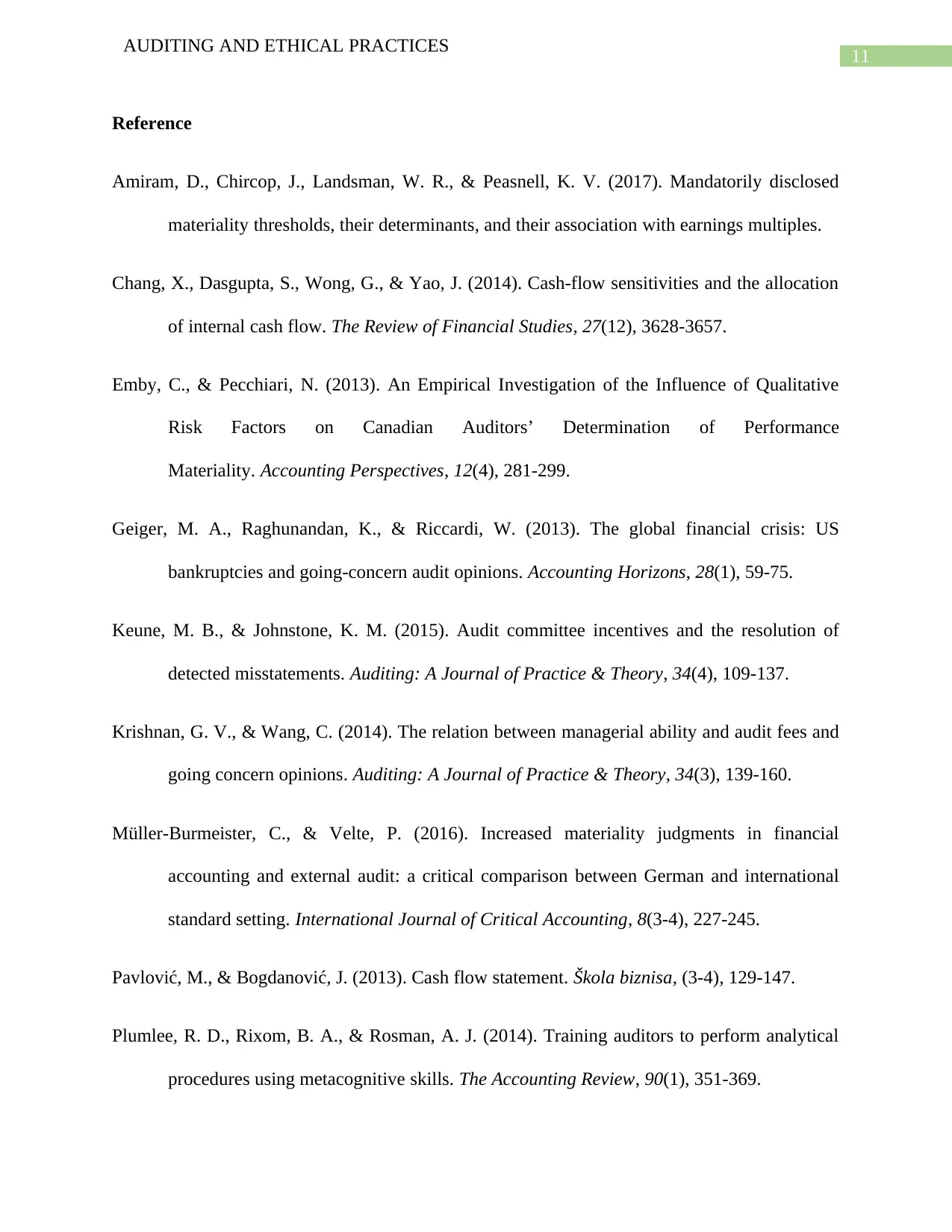
11
AUDITING AND ETHICAL PRACTICES
Reference
Amiram, D., Chircop, J., Landsman, W. R., & Peasnell, K. V. (2017). Mandatorily disclosed
materiality thresholds, their determinants, and their association with earnings multiples.
Chang, X., Dasgupta, S., Wong, G., & Yao, J. (2014). Cash-flow sensitivities and the allocation
of internal cash flow. The Review of Financial Studies, 27(12), 3628-3657.
Emby, C., & Pecchiari, N. (2013). An Empirical Investigation of the Influence of Qualitative
Risk Factors on Canadian Auditors’ Determination of Performance
Materiality. Accounting Perspectives, 12(4), 281-299.
Geiger, M. A., Raghunandan, K., & Riccardi, W. (2013). The global financial crisis: US
bankruptcies and going-concern audit opinions. Accounting Horizons, 28(1), 59-75.
Keune, M. B., & Johnstone, K. M. (2015). Audit committee incentives and the resolution of
detected misstatements. Auditing: A Journal of Practice & Theory, 34(4), 109-137.
Krishnan, G. V., & Wang, C. (2014). The relation between managerial ability and audit fees and
going concern opinions. Auditing: A Journal of Practice & Theory, 34(3), 139-160.
Müller-Burmeister, C., & Velte, P. (2016). Increased materiality judgments in financial
accounting and external audit: a critical comparison between German and international
standard setting. International Journal of Critical Accounting, 8(3-4), 227-245.
Pavlović, M., & Bogdanović, J. (2013). Cash flow statement. Škola biznisa, (3-4), 129-147.
Plumlee, R. D., Rixom, B. A., & Rosman, A. J. (2014). Training auditors to perform analytical
procedures using metacognitive skills. The Accounting Review, 90(1), 351-369.
AUDITING AND ETHICAL PRACTICES
Reference
Amiram, D., Chircop, J., Landsman, W. R., & Peasnell, K. V. (2017). Mandatorily disclosed
materiality thresholds, their determinants, and their association with earnings multiples.
Chang, X., Dasgupta, S., Wong, G., & Yao, J. (2014). Cash-flow sensitivities and the allocation
of internal cash flow. The Review of Financial Studies, 27(12), 3628-3657.
Emby, C., & Pecchiari, N. (2013). An Empirical Investigation of the Influence of Qualitative
Risk Factors on Canadian Auditors’ Determination of Performance
Materiality. Accounting Perspectives, 12(4), 281-299.
Geiger, M. A., Raghunandan, K., & Riccardi, W. (2013). The global financial crisis: US
bankruptcies and going-concern audit opinions. Accounting Horizons, 28(1), 59-75.
Keune, M. B., & Johnstone, K. M. (2015). Audit committee incentives and the resolution of
detected misstatements. Auditing: A Journal of Practice & Theory, 34(4), 109-137.
Krishnan, G. V., & Wang, C. (2014). The relation between managerial ability and audit fees and
going concern opinions. Auditing: A Journal of Practice & Theory, 34(3), 139-160.
Müller-Burmeister, C., & Velte, P. (2016). Increased materiality judgments in financial
accounting and external audit: a critical comparison between German and international
standard setting. International Journal of Critical Accounting, 8(3-4), 227-245.
Pavlović, M., & Bogdanović, J. (2013). Cash flow statement. Škola biznisa, (3-4), 129-147.
Plumlee, R. D., Rixom, B. A., & Rosman, A. J. (2014). Training auditors to perform analytical
procedures using metacognitive skills. The Accounting Review, 90(1), 351-369.
⊘ This is a preview!⊘
Do you want full access?
Subscribe today to unlock all pages.

Trusted by 1+ million students worldwide
1 out of 13
Related Documents
Your All-in-One AI-Powered Toolkit for Academic Success.
+13062052269
info@desklib.com
Available 24*7 on WhatsApp / Email
![[object Object]](/_next/static/media/star-bottom.7253800d.svg)
Unlock your academic potential
Copyright © 2020–2025 A2Z Services. All Rights Reserved. Developed and managed by ZUCOL.





